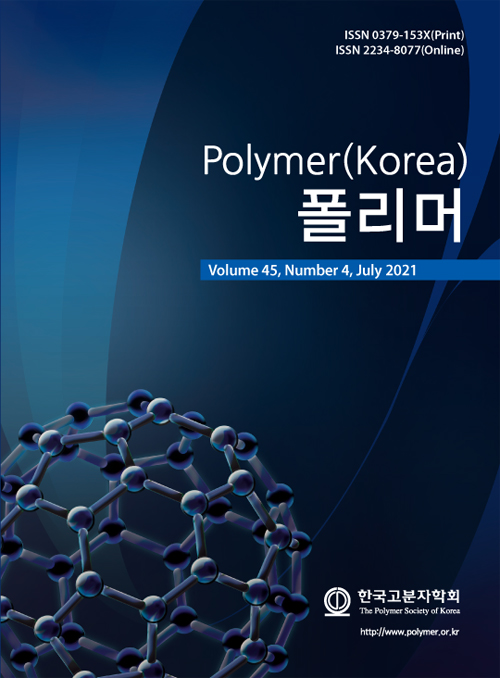- [Note]
- Improvement of Tensile Strength through Asymmetric Tool Path in Material Extrusion-Type 3D Printing
Department of Mechanical Design and Manufacturing Engineering, Graduate School of Seoul National University of Science and Technology, Seoul 01811, Korea
- 재료 압출 방식 3D 프린팅에서 비대칭 적층 경로의 적층을 통한 인장 강도 향상
서울과학기술대학교 기계디자인금형공학과
Reproduction, stored in a retrieval system, or transmitted in any form of any part of this publication is permitted only by written permission from the Polymer Society of Korea.
References
- 1. Hong, J. What's Between 3D Printing and High Polymer Science & Engineering. Polym. Sci. Tech. 2015, 26, 398-403.
- 2. Choi, B.-S.; Yoo, J. How Will the Emerging Technologies Change Industrial Landscapes?: Forecasting the Future and Its Strategic Implications. Sci. Tech. Pol. Inst. 2015, 3, 1-178.
- 3. Onwubolu, G. C.; Rayegani, F. Characterization and Optimization of Mechanical Properties of ABS Parts Manufactured by the Fused Deposition Modelling Process. Int. J. Manuf. Mater. 2014, 2014, 1-13.
-

- 4. Sood, A. K.; Ohdar, R. K.; Mahapatra, S. S. Parametric Appraisal of Mechanical Property of Fused Deposition Modelling Processed Parts. Mater. Des. 2010, 31, 287-295.
-

- 5. Benwood, C.; Anstey, A.; Andrzejewski, J.; Misra, M.; Mohanty, A. K. Improving the Impact Strength and Heat Resistance of 3D Printed Models: Structure, Property, and Processing Correlationships during Fused Deposition Modeling (FDM) of Poly(Lactic Acid). ACS Omega 2018, 3, 4400-4411.
-

- 6. Yoon, H. S.; Lyu, M.-Y.; Jin, S. C. Relationship between Deposition Strength and Cross-section Morphology of a Material Extrusion-type 3D Printing Manufactured Article. Polym. Korea 2018, 42, 752-762.
-

- 7. Park, S. J.; Park, J. H.; Lee, K. H.; Lyu, M.-Y. Deposition Strength of Specimens Manufactured Using Fused Deposition Modeling Type 3D Printer. Polym. Korea 2016, 40, 846-851.
-

- 8. Yao, T.; Deng, Z.; Zhang, K.; Li, S. A Method to Predict the Ultimate Tensile Strength of 3D Printing Polylactic Acid (PLA) Materials with Different Printing Orientations. Composites Part B 2019, 163, 393-402.
-

- 9. Woo, I. Y.; Lyu, M.-Y. Variations in the Impact Strength of Material Extrusion-type 3D Printed Specimens Depending on Tool Path and Building Direction. Polym. Korea 2020, 471-478.
-

- 10. Woo, I. Y.; Lyu, M.-Y. Variations in the Tensile Strength in Material Extrusion-type 3D Printed Specimens for Various Tool Paths. Polym. Korea 2020, 44, 769-775.
-

- 11. Kalpakjian, S.; Schmid, S. R. Manufacturing Processes for Engineering Materials,5th ed.; Translator Kim, N. S.; SungJIn Media Co.: Seoul, Korea, 2014.
- Polymer(Korea) 폴리머
- Frequency : Bimonthly(odd)
ISSN 0379-153X(Print)
ISSN 2234-8077(Online)
Abbr. Polym. Korea - 2023 Impact Factor : 0.4
- Indexed in SCIE
 This Article
This Article
-
2021; 45(4): 649-653
Published online Jul 25, 2021
- 10.7317/pk.2021.45.4.649
- Received on Mar 13, 2021
- Revised on Apr 20, 2021
- Accepted on Apr 20, 2021
 Correspondence to
Correspondence to
- Min-Young Lyu
-
Department of Mechanical Design and Manufacturing Engineering, Graduate School of Seoul National University of Science and Technology, Seoul 01811, Korea
- E-mail: mylyu@seoultech.ac.kr









 Copyright(c) The Polymer Society of Korea. All right reserved.
Copyright(c) The Polymer Society of Korea. All right reserved.